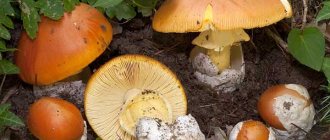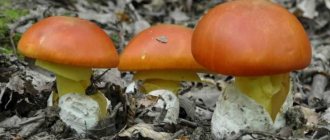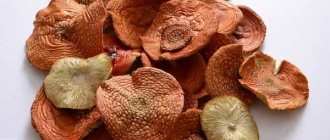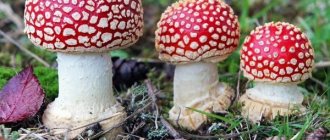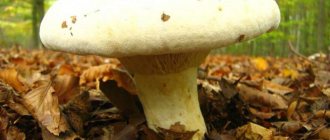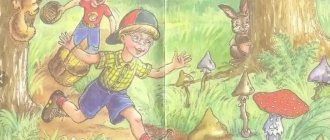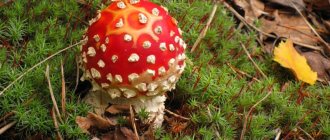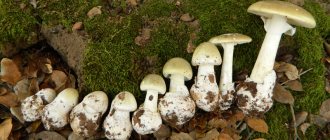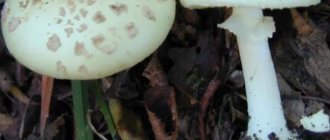The toadstool (Amanita citrina) is a forest dweller that does not leave anyone indifferent. It has a very remarkable appearance, as well as dangerous properties, for which some mushroom pickers do not like to collect it. This forest dweller is called the lemon or yellow-green fly agaric, largely due to the fact that it has similar shades of the cap. However, it is popularly known as the yellow toadstool. Belongs to the department Agaricomycetes, class Agariaceae, order Lamellar, family Amaranthaceae, genus Amanita. What is hidden under the cap of this certainly interesting mushroom? What nuances of its collection do you need to know? Is this mushroom poisonous? You will receive the answer to these questions in the text of the article.
Systematics, characteristics and description of the structure
Fungi are colloquially considered plants, but in fact they form a special kingdom, distinct from the other six known kingdoms of living organisms. The exact taxonomic classification of the toadstool: genus: Amanita (Amanita), species Amanita citrine (Amanita citrine).
In reference books and encyclopedias there are other names for this mushroom: lemon fly agaric, yellow-green fly agaric, pale green fly agaric, greenish fly agaric and even yellow pale toadstool.
The diameter of the cap of the toadstool mushroom is from 3–4 to 10 cm. In small mushrooms, the cap is almost comparable in size to the stem expanded at the base. At first, this part has an almost spherical shape. It is covered with a rough (not shiny!) film. As it grows, it becomes more and more prostrate, flat-convex or almost completely flat.
The color of the cap of young mushrooms is white, light yellow or slightly greenish. Later it becomes more intense. Pure white or gray varieties are occasionally found.
The cap of adult specimens is abundantly covered with brownish scales, clearly visible against the general greenish-lemon background.
The hymenophore is the lower surface of the cap that bears a layer of spore-producing cells. It is easy to see if the mushroom is turned over. In the fly agaric toadstool, it looks like narrow, frequent, radially arranged fragile plates adhered to the stem. Young mushrooms are white and turn yellow with age. In a ripe fruit, the hymenophore contains milky spore powder.
The stem of the mushroom is snow-white, straight, and in young specimens it has a tuberous swelling at the base. Height – 5–10 cm, occasionally more. In adult fruits, the stem is hollow, up to 2 cm in diameter; a fibrous ring, white or slightly yellowish, is clearly visible under the cap itself. Volva, that is, the remains of a common cover-cover at the base of the leg, adherent, not expressed.
The pulp is white, dense, sometimes with a yellowish tint under the skin. When broken, the color does not change. The taste is unpleasant. The smell is described as starchy, reminiscent of raw potatoes.
Benefits of funnelwort
First of all, this mushroom contains a huge amount of useful microelements, such as phosphorus, potassium and calcium. It is recommended for use by people who suffer from muscle cramps, have increased dry skin and metabolic disorders, as well as anyone suffering from problems with the central nervous system, osteoporosis and hypertension. Experts often advise people who have a calcium deficiency to include funnelweed in their diet. It is also recommended to use it for better bone healing.
In addition, the mushroom contains vitamins such as PP, D, A and B. If you use it systematically, you can solve many health problems without the use of chemicals and medications. It has an antiparasitic effect and will remove all toxins from the body.
But you should not use it too often; it is better to maintain a certain interval, approximately 1 - 3 days.
This mushroom is also used as a folk remedy; it replaces antibiotics. Old Believers often resorted to his help in order to relieve the patient’s inflammatory processes, as well as to get rid of infection. Excellent chemical composition has a beneficial effect on the human immune system and significantly strengthens it.
Some people who started consuming this mushroom regularly noticed that their vision improved.
The funnel funnel must be present in the diet of children, as it contributes to the proper development of the body. But you need to be very careful, excessive consumption of this mushroom can lead to negative consequences.
The nutritional value
We have already written earlier that there is almost no protein in the mushroom; per 100 g of product it contains only one, 1.5 g. Fat contains 0.5 g, and carbohydrates 6.8 g. But it is worth noting that the mushroom contains a fairly large amount of dietary fiber, almost 4 g per 100 g.
Funnelwort is excellent for people with diabetes, as it contains only 1.1 g of dextrose.
Features, times and places of fruiting in nature
The toadstool mushroom is undemanding to growing conditions, therefore it lives almost everywhere in the temperate zone and even the tundra in Eurasia and North America. On the territory of Russia it is found in forests of all types.
Mycorrhiza (a symbiotic association with the roots of a plant) forms both with deciduous trees (birch, oak, aspen, etc.) and with conifers (pine, spruce).
Prefers acidic, poor, sandy soils. Requires long daylight hours, sufficient humidity and warm weather.
The fruiting period is relatively short, but abundant. The peak in the middle zone occurs in mid-August and September, after which the mycelium goes into hibernation.
Where do moths live?
Food moths lay eggs in food, from which voracious larvae emerge. Such products are various cereals, flour, nuts, seeds, dried fruits, pasta, candies and cookies. The caterpillar is very small and practically does not move, so its presence in products can only be detected by accident.
The furniture moth caterpillar is dangerous because its delicacy is outerwear made of natural wool and fur. This type of caterpillar lives in a portable case, which the caterpillar itself creates from food debris and a silk-like substance secreted by its body. The caterpillar gnaws hairs and villi, causing irreparable damage to clothing. As a rule, this caterpillar lives in closets and suitcases.
Although the furniture caterpillar larva is small in size, it has powerful gnawing jaws, with the help of which the caterpillar “cuts” the fur on fur coats, fur collars and hats, leaving unsightly bald patches on the products.
Clothes moths (house moths) live in houses and apartments. Its caterpillars eat cotton products and also chew silk upholstery. Only caterpillars cause damage, since butterflies do not have a gnawing type of mouthparts.
How to distinguish false doubles of an inedible mushroom?
- Amanita toadstool can have a white or very faint color. This makes it similar to the white variety of the toadstool or other types of deadly poisonous fly agaric (spring, stinking fly agaric).
- The cap of the fly agaric toadstool is lemon-yellow or yellow-green, rough, non-fibrous, covered with flakes. The cap of the pale grebe is green or yellow-green, smooth, permeated with brown fibers.
- The leg of the fly agaric has a tuberous base with an adherent, not pronounced volva. This part of the toadstool is free, not attached.
- The poisonous gray (grey-pink, porphyry) fly agaric (Amanita porphyria) can be confused with the toadstool. It is similar in appearance and smell to the inedible mushroom, but differs from it in the color of the cap, which combines brown, gray-violet and gray-purple tones.
Important! You should absolutely not collect, let alone eat, unfamiliar or questionable mushrooms! This could be deadly!
How poisonous?
Fly agaric is a poisonous mushroom. Especially the royal one.
They try not to even use this mushroom as a raw material for medicines, it can cause such serious harm to health. Unlike other representatives of the fly agaric species, such as red and black mushrooms, it contains muscimol and ibotenic acid.
2 hours after eating mushrooms, people began to experience symptoms of poisoning. People complained of severe stomach pain, followed by vomiting and upset bowel movements.
After this, people began to complain of severe nervous excitement. Others began to see unprecedented animals and dead relatives.
A few days later, the mushroom pickers finally came to their senses. However, until recently they did not understand what happened to them. Such an experiment seriously affected the state of health. For example, there were consequences for the liver, kidneys and nervous system. It is believed that mushroom pickers simply did not finish cooking the mushrooms, thereby not killing the poisonous properties. However, given what happened, it is still worth being on guard.
Hallucinogenic effect
Why are royal fly agarics dangerous? They tend to accumulate salts of heavy metals in their composition. Most often these are sodium salts. When studying the royal fly agaric mushrooms, this feature was identified in them in 1939. The research was carried out by Scandinavian scientists using Scandinavian royal fly agaric mushrooms. They collected about a kilogram of dry fruiting bodies. According to the tests carried out, it was revealed that there are about 150 mg of vanadium per kilogram. This means that this is a very significant figure that can cause significant damage to the human body. It is vanadium that is responsible for indigestion. However, the combination of vanadium and ibotenic acid is responsible for the hallucinogenic effect experienced by many people who have eaten fly agaric.
The effects of this mushroom vary widely depending on how susceptible the body is to such substances. The location of the forest dweller and the dosage also matter.
After consumption, after one to 2 hours, the first signs begin to appear. They are characterized by convulsions, trembling and a strong feeling of restlessness. Some people, on the contrary, claim that they feel very sleepy and overworked.
If a person nevertheless relaxes and falls asleep, he is not sleeping fully, but is in a state of half-asleep. At this time, he sees visions, and also develops increased sensitivity to sounds around him.
As a result of the impact of sounds on a damaged nervous system, visual hallucinations appear that are poorly distinguishable from reality.
However, depending on a person’s health, as well as the state of his psyche, the hallucinogenic effect manifests itself in different ways. As a rule, the duration of this state lasts from 4 to 8 hours. After the hallucinogenic effect subsides, the person will experience a hangover syndrome.
By the way, as many people who have been poisoned by the royal fly agaric say, a feeling of nausea persists during the hallucination. And also, there are characteristic pains in the stomach.
Is it usable?
In different sources, the toadstool mushroom is considered either inedible or slightly poisonous. The bouquet of its active substances has been studied in detail. The mushroom contains bufotenine, dimethyltryptamine, 5-methoxydimethyltryptamine, they can cause mental disorders and hallucinations. In addition, it contains α-amanitin and phalloidin, which are deadly toxins, in small quantities.
Eating fly agaric mushroom does not pose any particular danger to life. However, eating large quantities of it raw can lead to gastric upsets.
Sometimes they indicate that if this mushroom is boiled several times, draining the water, then harmful substances during such processing will be destroyed and will be removed.
However, inexperienced mushroom pickers may accidentally confuse the toadstool with the deadly poisonous toadstool or other types of fly agaric.
Therefore, it is better not to engage in such dubious culinary experiments at all, especially since the mushroom simply tastes nothing impressive.
Can toadstool poisoning happen and what are its symptoms?
Since this mushroom is mildly poisonous, fatal poisoning has not been described. Poisonous toxins are contained in minimal concentrations, and therefore even eating raw mushrooms in significant quantities usually only causes diarrhea with corresponding symptoms. .
All species of the genus Amanita:
| Red fly agaric (Amanita muscaria) | Bright yellow fly agaric (Amanita gemmata) | Panther fly agaric (Amanita pantherina) |
| Porphyry fly agaric (Amanita porphyria) | Fly agaric (Amanita excelsa) | Green fly agaric (Amanita phalloides) |
| Amanita virosa (Amanita virosa) | Amanita citrina (Amanita citrina) | Gray-pink fly agaric (Amanita rubescens) |
| Caesar's mushroom (Amanita caesarea) | Fly agaric (Amanita ovoidea) | Rough fly agaric (Amanita franchetii) |
| Strange float (Amanita ceciliae) | Gray floater (Amanita vaginata) | Yellow-brown floater (Amanita fulva) |
| Saffron float (Amanita crocea) | White floater (Amanita nivalis) | Royal fly agaric (Amanita regalis) |
| Fly agaric (Amanita strobiliformis) |
Red fly agaric (Amanita muscaria) Bright yellow fly agaric (Amanita gemmata) Panther fly agaric (Amanita pantherina) Porphyry fly agaric (Amanita porphyria) Tall fly agaric (Amanita excelsa) Green fly agaric (Amanita phalloides) Stinking fly agaric (Amanita virosa) Toadstool fly agaric (Amanita citrina) Gray-pink fly agaric (Amanita rubescens)Caesar's mushroom (Amanita caesarea) Egg-shaped fly agaric (Amanita ovoidea) Rough fly agaric (Amanita franchetii) Strange float (Amanita ceciliae) Gray float (Amanita vaginata) Yellow-brown float (Amanita fulva) Saffron float (Amanita crocea) Snow-white float (Amanita nivalis) Royal fly agaric (Amanita regalis) Pineal fly agaric (Amanita strobiliformis)
TOP
If you doubt the edibility of the mushrooms you find, do not take them. The site administration does not bear any responsibility for the actions of people taken on the basis of information received on the site. Some types of poisonous mushrooms cannot be identified without special equipment and can be confused with edible ones. For all questions related to the operation of the site, please contact the administration mailbox Copyright ©2016 - 2022
Video gallery
Video reviews
A selection of videos with descriptions and recipes for preparing mushrooms
Mushroom experts of the Russian Federation TV, MAYGLI. Mushrooms and Mushroom Pickers, Mushrooms BAK – Mushrooms of the LHC
Photos of this mushroom from the outskirts of St. Petersburg
False death cap mushroom ( Amanita citrina
) in north-west area of Monrepo (Mon Repos) Park. Vyborg, Russia, September 14, 2013
- Texas mushrooms
- Mushrooms of Qatar
| Novoposelkovaya ulitsa, 45, Vyborg, Leningrad Oblast, Russia False death cap mushrooms (Amanita citrina ) near Lisiy Nos, south from Saint Petersburg. Russia, September 3, 2016 | Primorskoye sh., g. St. Petersburg, Russia, 197755 False death cap mushrooms (Amanita citrina ) near Dibuny, west from Saint Petersburg. Russia, September 7, 2016 | Zapadniy Skorostnoy Diameter, g. St. Petersburg, Russia, 197758 False deathcap (Amanita citrina ) in Dibuny, near Saint Petersburg. Russia, August 20, 2017 | Unnamed Road, Sankt-Petersburg, Russia, 197758 False deathcap mushrooms (Amanita citrina ) near Lembolovo, 40 miles north from Saint Petersburg. Russia, September 9, 2017 | Unnamed Road, Leningradskaya oblast', Russia, 188695 Young false deathcap mushroom (Amanita citrina ) in Blizhnie Dubki area near Lisiy Nos, west from Saint Petersburg. Russia, September 11, 2017 | Primorskoye Shosse, Sankt-Peterburg, Russia, 197755 Dissected false deathcap mushroom (Amanita citrina ) in Blizhnie Dubki area near Lisiy Nos, west from Saint Petersburg. Russia, September 11, 2017 | Primorskoye Shosse, Sankt-Peterburg, Russia, 197755 False deathcap mushroom (Amanita citrina ) in Sosnovka Park. Saint Petersburg, Russia, September 16, 2017 | Ulitsa Zhaka Dyuklo, 67, St Petersburg, Russia, 194214 Dissected false deathcap mushroom (Amanita citrina ) in Sosnovka Park. Saint Petersburg, Russia, September 16, 2017 | Ulitsa Zhaka Dyuklo, 67, St Petersburg, Russia, 194214 False deathcap mushrooms (Amanita citrina ) in a coastal forest between Lisiy Nos and Olgino, west from Saint Petersburg. Russia, September 6, 2018 | Primorskoye Shosse, Sankt-Peterburg, Russia, 197755 |
Interesting Facts
- Some toxins of the fly agaric grebes are close to those produced by some species of rare amphibians.
- The toadstool is found even in the southern hemisphere - in Australia and New Zealand.
- The mushroom is not used in ordinary folk medicine, but is part of the potions used by shamans and healers of some small peoples. There is no scientific evidence of the therapeutic effectiveness of such drugs.
Information sources
- Wasser S.P. Flora of mushrooms of Ukraine. Amanital mushrooms / resp. ed. K. A. Kalamaes. — K.: “Naukova Dumka”, 1992
- Mushrooms: Directory / Transl. from Italian F. Dvin. — M.: “Astrel”, “AST”, 2001
- Grunert G.
Mushrooms / trans. with him. — M.: “Astrel”, “AST”, 2001 - Serzhanina G.I.
Hat mushrooms of Belarus. - Minsk: Science and Technology, 1984
